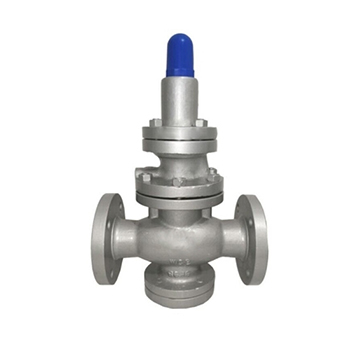How does Steam Pressure Reducing Valve Work?
A steam pressure-reducing valve is a common device for controlling steam pressure, which is widely used in various industrial fields. Its function is to automatically adjust the steam flow within a certain pressure range to keep the steam pressure within the set range, thus ensuring the normal operation of the system. This article will introduce the working principle and application of the steam pressure-reducing valve, I hope it will be helpful to you.
How steam pressure reducing valve work
The working principle of the steam pressure regulator valve is based on the principle of thermodynamics, and its internal structure is mainly composed of the main body, the regulating valve core, the spring, the regulating nut, the valve seat, and so on. When the steam enters the pressure-reducing valve, due to the restriction of the pressure-reducing valve, the flow of the steam is limited within a certain range, thereby reducing the steam pressure. When the steam pressure is lower than the set value, the spring will push the regulating spool upward, so that the valve port will gradually open, increasing the steam flow, thereby increasing the steam pressure; conversely, when the steam pressure is higher than the set value, the spring will adjust the spool. Pressing down will gradually close the valve port, reducing steam flow and thus reducing steam pressure.
When the steam pressure regulator valve reduces the inlet pressure to a certain required outlet pressure through the opening and closing parts, the outlet pressure will remain stable. When the steam pressure-reducing valve leaves the factory, adjust the tension spring so that it is in an uncompressed state, and at this time, the main valve disc and the auxiliary valve disc are in a closed state.
When in use, press the adjustment screw clockwise to compress the adjustable tension spring to move the diaphragm to the top, and the auxiliary valve disc will open. The medium enters the piston from the A hole through the auxiliary valve seat and reaches the B hole. Under the influence of the medium pressure, the piston moves downward to push the main valve disc to separate from the main valve seat, so that the medium flows to the back of the valve and enters the diaphragm from hole C together.
When the valve pressure exceeds the set pressure, the diaphragm is pushed up to compress the tension spring, and then the auxiliary disc moves to the closing target, so that the medium flowing into the piston decreases, and the pressure also decreases. At this time, the main valve disc moves up and down under the push of the spring tension, so that the gap between the main valve disc and the main valve seat is reduced, and the medium flow rate is also reduced accordingly so that the pressure behind the valve also drops to a new balance.
Application of steam pressure-reducing valve
Steam pressure-reducing valves are widely used in various steam systems, such as boilers, power plants, chemical plants, food processing plants, etc. Its function is to ensure the normal operation of the system and avoid accidents and accidents caused by too high or too low steam pressure.
The steam pressure-reducing regulator valve should generally be installed in the pipeline. The steam pressure-reducing valve is one of the indispensable accessories of the pneumatic control valve. In the boiler system, the function of the steam pressure-reducing valve is to control the steam pressure at the boiler outlet to ensure the stable operation of the steam pressure within a certain range. Excessively high steam pressure will lead to boiler explosion or other safety accidents, while too low steam pressure will affect the thermal efficiency and production efficiency of the boiler. Therefore, in the boiler system, the steam pressure-reducing valve is an indispensable control device.
The 1-inch steam pressure regulator is suitable for industrial water supply, fire water supply, and domestic water pipe network systems. The steam pressure-reducing valve mainly controls the fixed outlet pressure of the main valve. The outlet pressure of the main valve does not change with the change of the inlet pressure, and the outlet pressure does not change because of the change of the outlet flow of the main valve. Steam pressure-reducing valves have the function of improving system operation and water-saving potential. According to statistics, the water-saving effect of a steam pressure-reducing valve is about 30%.
Steam pressure-reducing valves are also widely used in high-rise buildings, areas with high water pressure, urban water supply pipe networks, and mines to ensure that each water consumption point in the water supply system can obtain appropriate water pressure and flow.
Features
Economic advantages of producing and delivering high-pressure steam:
- Increase the heat storage capacity of the boiler to meet the peak load capacity.
- The pipe diameter required to transport steam under high pressure is small, and the pipe and installation costs are low.
- The surface area of the pipe is small, the cost of heat preservation is low, and the loss of heat dissipation is small.
- Obtain drier steam at the steam use point by decompression.
Advantages of making steam at low pressure at the steam point:
- Steam has higher latent heat energy at lower pressure, which can improve steam utilization efficiency.
- After decompression, the dryness of the steam increases, which improves the quality of the steam.
- Reduce the amount of secondary steam in the discharged condensed water.
Safety:
- Ensure that the steam pressure downstream of the pressure-reducing valve is stable and meets the production requirements.
- Ensure the production quality of the product and avoid product problems caused by excessive temperature.
- Protect equipment from overpressure and protect the personal safety of operators.
Efficient:
- Realize controlling the temperature of the steam by controlling the pressure of the steam, and then control the product quality.
- To meet the different pressure requirements of different equipment.

